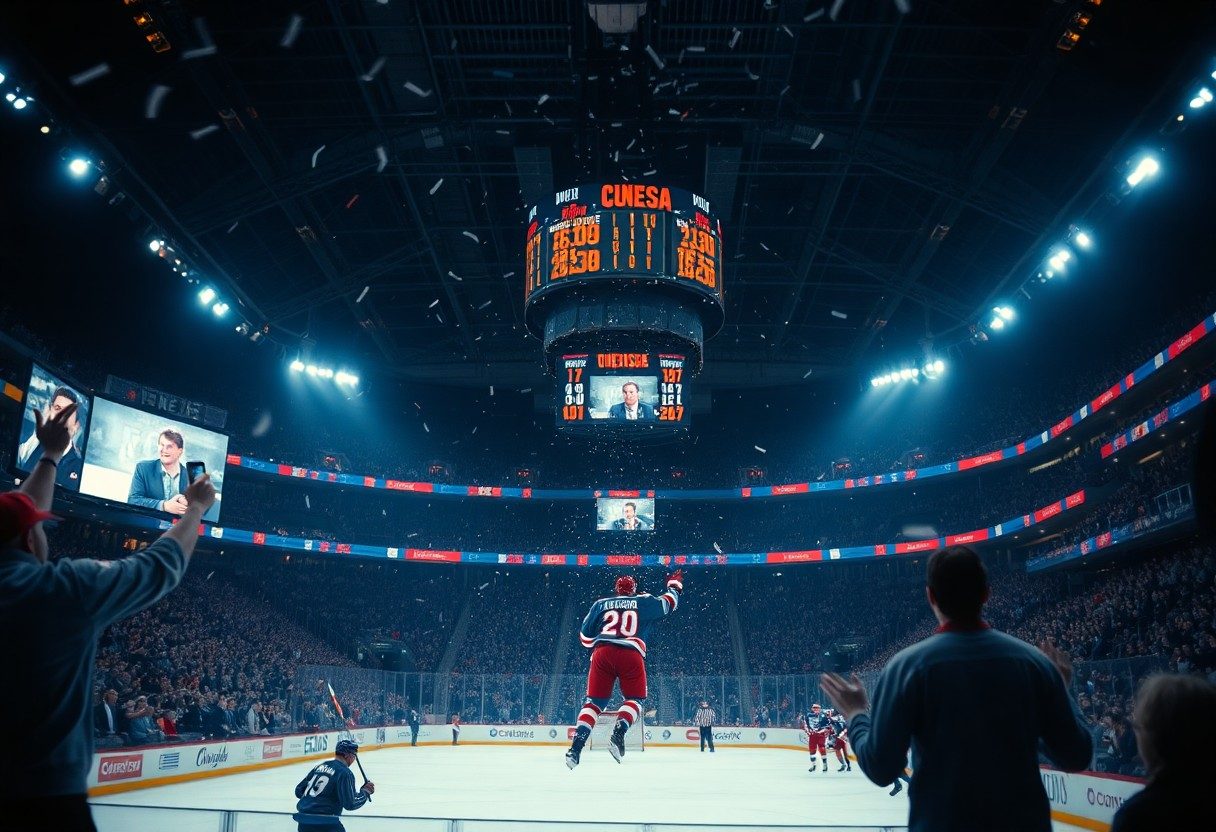There’s a rich tapestry of memorable events in the NHL that have not only defined seasons but also shaped the future of the sport. As you explore these iconic moments, you’ll gain insight into the pivotal plays and decisions that transformed hockey, from unforgettable championships to game-changing rule changes. Understanding these milestones deepens your appreciation for the game and highlights how they continue to influence players and fans alike. Join us as we research into the unforgettable moments that altered the trajectory of hockey history.
The Miracle on Ice: 1980
To many, the Miracle on Ice stands as one of the most significant moments in sports history, encapsulating the triumph of amateur athletes over the seemingly invincible Soviet team during the 1980 Winter Olympics. This shocking victory not only rallied the American spirit but also symbolized a pivotal shift in Cold War dynamics, where sport became an arena for ideological clashes.
Overview of the Event
Overview, the Miracle on Ice took place on February 22, 1980, at Lake Placid, New York, where the U.S. men’s hockey team, composed mostly of college players, faced off against the seasoned Soviet squad. This match was marked by its intense atmosphere and high stakes, culminating in a thrilling 4-3 victory for the underdog U.S. team, forever etching the event into the annals of sports lore.
Impact on U.S.-Soviet Relations
Relations between the U.S. and the Soviet Union shifted significantly following the Miracle on Ice, as the game amplified national pride and provided hope during a time of geopolitical tension. It served as a reminder of American resilience and capability, leading to a more profound cultural awakening among citizens, who began to view their country as united against a common adversary.
But the implications of the game extended beyond the rink. The victory fostered a sense of American exceptionalism and unity at a time when the nation faced economic challenges and international uncertainty. As the U.S. celebrated this remarkable triumph, it also prompted discussions about national identity and the role of sports in shaping political narratives, proving that sometimes, victories on the ice can resonate far beyond the game itself.
Wayne Gretzky Trade: 1988
Now, one trade in NHL history stands out above all others: the 1988 deal that sent Wayne Gretzky to the Los Angeles Kings. This pivotal moment not only altered the landscape of the league but also redefined the marketing of hockey in a non-traditional market. Gretzky’s move to Los Angeles opened doors for the sport’s growth in new regions, making hockey a true national pastime in places it had never thrived before.
The Shockwaves of the Trade
About the implications of Gretzky’s trade, the effects rippled through the league and beyond. Fans were stunned, rivals took notice, and franchises began to recalibrate their strategies. The Kings gained a massive following almost overnight, while other teams scrambled to shake up their rosters in pursuit of greater talent and marketability. This iconic trade changed the game, resonating deeply throughout the hockey community.
Gretzky’s Legacy in the NHL
To understand Gretzky’s enduring legacy in the NHL, you must consider the records he set and the influence he wielded. As the all-time leader in goals and assists, Gretzky not only achieved individual greatness but also brought unprecedented popularity to the sport. His style of play, characterized by vision and intelligence, inspired countless players and helped elevate the game to new heights.
Shockwaves from Gretzky’s achievements reverberated throughout the NHL, as young players sought to emulate his unique approach to the game. The standard he set paved the way for the evolution of hockey, pushing teams toward a greater emphasis on skill and finesse. Additionally, his charisma and media presence helped popularize the sport among new audiences, truly solidifying his status as “The Great One” and leaving an indelible mark on hockey history.
The Expansion Era: 1990s
It was during the 1990s that the NHL underwent a transformative phase, with significant franchise expansions that forever altered the face of hockey. This era introduced new teams and a fresh playing dynamic, allowing the sport to reach a broader audience while creating new fan bases and rivalries. The expansion not only diversified the locations of teams but also contributed to the overall growth of hockey culture across North America.
Teams Added and Their Impact
Against a backdrop of shifting demographics and rising interest in hockey, the NHL added teams in cities like Tampa Bay, Ottawa, and San Jose. These franchises injected life into the league, leading to increased competition and providing opportunities for players from various backgrounds. This expansion not only challenged the traditional strengths of long-standing teams but also encouraged a new wave of talent to enter the league.
The Growth of the Game
Added to the excitement of new franchises, the 1990s also saw a concerted effort to promote hockey at grassroots levels and increase its visibility in the mainstream sports landscape.
Expansion played a significant role in popularizing hockey in non-traditional markets, as teams began to develop strong community ties. With initiatives aimed at youth engagement, hockey schools, and local programs, you could witness a steadily growing appreciation for the game. The introduction of new teams spurred increased media coverage and television contracts, directly correlating with rising viewership and a burgeoning fan base. This foundation laid during the 1990s has helped propel hockey into a globally recognized sport that you see today.
The Lockout: 2004-2005
Unlike any other period in NHL history, the 2004-2005 season was completely wiped out due to a lockout, marking the first time a major professional sports league in North America lost an entire season. This unprecedented event not only altered the league’s landscape but also significantly impacted player contracts, team dynamics, and fan engagement, all of which would resonate for years to come.
Reasons for the Lockout
Below the surface, the 2004-2005 lockout stemmed from deep-seated disputes over player salaries, revenue sharing, and the need for a salary cap. The NHLPA and team owners struggled to find common ground, resulting in bitter negotiations that highlighted the financial disparities and challenges facing the league at the time.
Changes to the Game Post-Lockout
Around the league, the aftermath of the lockout saw significant changes implemented to rejuvenate the game and improve its competitive balance. Key adjustments included the introduction of a salary cap, stricter enforcement of rules to enhance offensive play, and modifications to the structure of the game to prevent teams from dominating through physicality alone.
Even with these changes, the emphasis on speed and skill transformed how you watch the game. With the removal of the two-line pass rule and stricter penalties for obstruction, teams began to focus on faster, more dynamic play. These changes not only revitalized interest in the NHL but also set a new standard for the style of play, allowing your favorite teams to showcase their talents in more thrilling ways.
The Rise of Analytics: 2010s
Your understanding of the game transformed in the 2010s as analytics began to dominate the NHL landscape. This era marked a significant shift, where teams increasingly relied on data to shape strategies, improve player performance, and gain a competitive edge.
Introduction of Advanced Metrics
Before the 2010s, hockey metrics primarily focused on traditional statistics like goals, assists, and plus-minus. The adoption of advanced metrics introduced a new depth to performance analysis, emphasizing elements like:
|
These metrics provided a nuanced view of player and team performance, enabling more strategic decision-making. |
How Analytics Changed Team Strategies
After embracing analytics, teams began altering their gameplay philosophies and recruitment processes. Coaches utilized data to refine line combinations, defensive strategies, and shot selection, focusing on maximizing scoring chances and minimizing risks.
Another notable change was in player evaluation and acquisition. With advanced stats, you could predict player contributions beyond traditional statistics, helping teams identify potential stars who might have previously been overlooked. This shift not only improved team performance but also transformed how you, as a fan, appreciate the game, revealing the complex strategies behind each play and enhancing your viewing experience.
Women’s Hockey Milestones
All across the globe, women’s hockey has steadily gained recognition and support, transforming into a powerful force within the sport. From grassroots initiatives to international competitions, the dedication of players and advocates has paved the way for significant milestones in women’s hockey history. You’ll witness how these achievements have not only inspired aspiring female athletes but have also contributed to the overall growth and popularity of the sport.
The Growth of Women’s Hockey
Milestones in women’s hockey showcase the sport’s evolution, from the establishment of leagues to national teams representing countries worldwide. As you explore into this journey, you’ll discover how participation rates have soared, media coverage has increased, and the overall perception of women’s hockey has shifted dramatically, making it an important component of the hockey landscape.
Notable Moments in Women’s NHL History
Before the NHL fully embraced the women’s game, landmark events laid the foundation for future progress and visibility. You can explore how pivotal matches, groundbreaking partnerships, and historic firsts shaped the path for women’s involvement in the sport. These events not only captured the attention of fans but also highlighted the immense talent and potential within women’s hockey.
In addition to these key moments, the introduction of the NWHL and later the PWHPA has created platforms for female athletes to showcase their skills. You’ll learn about the significance of the first-ever women’s hockey game at Madison Square Garden and players like Hayley Wickenheiser breaking barriers. These incredible moments have not only inspired countless athletes but have also served as stepping stones towards greater acceptance and recognition for women in the sport.
Summing up
As a reminder, iconic NHL moments have not only defined eras of hockey but have also profoundly influenced its evolution. By understanding these pivotal events, you gain insight into how they shaped the game’s culture, fan engagement, and the rules you appreciate today. From record-breaking performances to epic playoff battles, each moment contributes to your knowledge and appreciation of the sport. Embrace the history that has made hockey what it is, and let these unforgettable experiences enrich your passion for the game.












